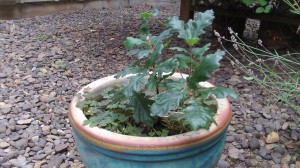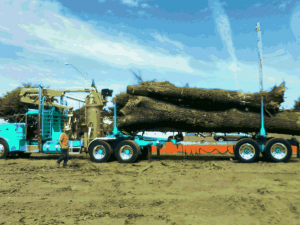
This little oak probably wants to be transplanted in a suitable spot pretty soon.
The world can always use more trees, especially oaks, so I was happy to hear that the ancient trees cut down on the Lowe’s site in Albany may yet have offspring in the vicinity.
Mark Azevedo,a member of the volunteer Albany Tree Commission, told the city council that Lowe’s and its contractor had donated the 44 tons of oak wood from the site — some of it more than 200 years old — to a school program that saws the material for lumber to be reworked into various products. Good move!
But also, and to my mind even more useful, Azevedo said acorns from the trees had been collected with the view toward propagating them and planting the new oaks in the city park south of the Lowe’s site on, appropriately, Oak Street.
The trouble with oaks, it seems to me, is that they take a long time to grow to a respectable size. So even if we manage to see some results from planting acorns, chances are we won’t see them as grown-up trees. But decades from now, others will. And as a reason to plant as many oaks as we can in as many suitable places as we can find, that’s plenty good enough. (hh)
From David Moore, on Facebook: What we need are trees that bear food. The City has required developers and others to plant thousands of trees and bushes over the years; and almost none of them bear any kind of food. How much healthier and happier would people in Albany be if we lived in a urban garden, instead of an urban forest?
Well, fruit trees require a good deal of care, including pest control if you want decent apples or pears, plus arduous continual cleanup in late summer if you don’t. So I doubt they can be required. And don’t forget, oaks produce food too, just not for us. (hh)

Mark Azevedo’s cell phone shot of Mike Brown loading Lowe’s oaks for transport to the Kenagy Family Farm for storage.
POSTSCRIPT: Mark Azevedo reports that the plan for the Lowe’s acorns is to have them planted in pots and cared for by the residents of the Oak Creek Youth Correctional Facility to get them established and to have the seedling trees planted at Kinder Park and the East Thornton Lake Natural Area by residents of the community. He says the seedling trees will need two years to get established in pots to transplant and survive well in a natural setting, and the acorns will be potted this fall.

Why we plant oaks
This little oak probably wants to be transplanted in a suitable spot pretty soon.
The world can always use more trees, especially oaks, so I was happy to hear that the ancient trees cut down on the Lowe’s site in Albany may yet have offspring in the vicinity.
Mark Azevedo,a member of the volunteer Albany Tree Commission, told the city council that Lowe’s and its contractor had donated the 44 tons of oak wood from the site — some of it more than 200 years old — to a school program that saws the material for lumber to be reworked into various products. Good move!
But also, and to my mind even more useful, Azevedo said acorns from the trees had been collected with the view toward propagating them and planting the new oaks in the city park south of the Lowe’s site on, appropriately, Oak Street.
The trouble with oaks, it seems to me, is that they take a long time to grow to a respectable size. So even if we manage to see some results from planting acorns, chances are we won’t see them as grown-up trees. But decades from now, others will. And as a reason to plant as many oaks as we can in as many suitable places as we can find, that’s plenty good enough. (hh)
From David Moore, on Facebook: What we need are trees that bear food. The City has required developers and others to plant thousands of trees and bushes over the years; and almost none of them bear any kind of food. How much healthier and happier would people in Albany be if we lived in a urban garden, instead of an urban forest?
Well, fruit trees require a good deal of care, including pest control if you want decent apples or pears, plus arduous continual cleanup in late summer if you don’t. So I doubt they can be required. And don’t forget, oaks produce food too, just not for us. (hh)
Mark Azevedo’s cell phone shot of Mike Brown loading Lowe’s oaks for transport to the Kenagy Family Farm for storage.
POSTSCRIPT: Mark Azevedo reports that the plan for the Lowe’s acorns is to have them planted in pots and cared for by the residents of the Oak Creek Youth Correctional Facility to get them established and to have the seedling trees planted at Kinder Park and the East Thornton Lake Natural Area by residents of the community. He says the seedling trees will need two years to get established in pots to transplant and survive well in a natural setting, and the acorns will be potted this fall.
Tags: Albany Tree Commission, Lowe's, oaks